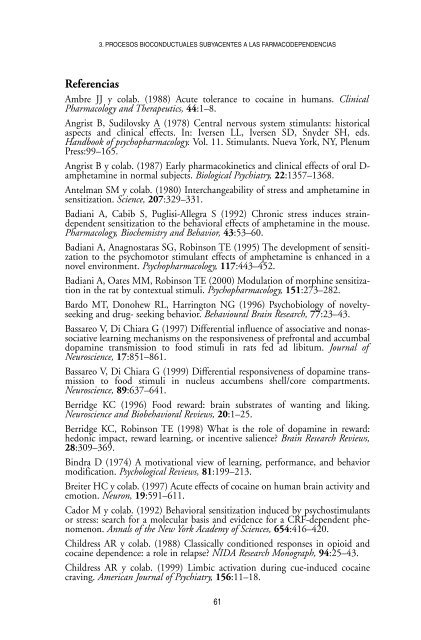Neurociencia del consumo y dependencia de sustancias psicoactivas
Neurociencia del consumo y dependencia de sustancias psicoactivas
Neurociencia del consumo y dependencia de sustancias psicoactivas
Create successful ePaper yourself
Turn your PDF publications into a flip-book with our unique Google optimized e-Paper software.
3. PROCESOS BIOCONDUCTUALES SUBYACENTES A LAS FARMACODEPENDENCIAS<br />
Referencias<br />
Ambre JJ y colab. (1988) Acute tolerance to cocaine in humans. Clinical<br />
Pharmacology and Therapeutics, 44:1–8.<br />
Angrist B, Sudilovsky A (1978) Central nervous system stimulants: historical<br />
aspects and clinical effects. In: Iversen LL, Iversen SD, Sny<strong>de</strong>r SH, eds.<br />
Handbook of psychopharmacology. Vol. 11. Stimulants. Nueva York, NY, Plenum<br />
Press:99–165.<br />
Angrist B y colab. (1987) Early pharmacokinetics and clinical effects of oral Damphetamine<br />
in normal subjects. Biological Psychiatry, 22:1357–1368.<br />
Antelman SM y colab. (1980) Interchangeability of stress and amphetamine in<br />
sensitization. Science, 207:329–331.<br />
Badiani A, Cabib S, Puglisi-Allegra S (1992) Chronic stress induces strain<strong>de</strong>pen<strong>de</strong>nt<br />
sensitization to the behavioral effects of amphetamine in the mouse.<br />
Pharmacology, Biochemistry and Behavior, 43:53–60.<br />
Badiani A, Anagnostaras SG, Robinson TE (1995) The <strong>de</strong>velopment of sensitization<br />
to the psychomotor stimulant effects of amphetamine is enhanced in a<br />
novel environment. Psychopharmacology, 117:443–452.<br />
Badiani A, Oates MM, Robinson TE (2000) Modulation of morphine sensitization<br />
in the rat by contextual stimuli. Psychopharmacology, 151:273–282.<br />
Bardo MT, Donohew RL, Harrington NG (1996) Psychobiology of noveltyseeking<br />
and drug- seeking behavior. Behavioural Brain Research, 77:23–43.<br />
Bassareo V, Di Chiara G (1997) Differential influence of associative and nonassociative<br />
learning mechanisms on the responsiveness of prefrontal and accumbal<br />
dopamine transmission to food stimuli in rats fed ad libitum. Journal of<br />
Neuroscience, 17:851–861.<br />
Bassareo V, Di Chiara G (1999) Differential responsiveness of dopamine transmission<br />
to food stimuli in nucleus accumbens shell/core compartments.<br />
Neuroscience, 89:637–641.<br />
Berridge KC (1996) Food reward: brain substrates of wanting and liking.<br />
Neuroscience and Biobehavioral Reviews, 20:1–25.<br />
Berridge KC, Robinson TE (1998) What is the role of dopamine in reward:<br />
hedonic impact, reward learning, or incentive salience? Brain Research Reviews,<br />
28:309–369.<br />
Bindra D (1974) A motivational view of learning, performance, and behavior<br />
modification. Psychological Reviews, 81:199–213.<br />
Breiter HC y colab. (1997) Acute effects of cocaine on human brain activity and<br />
emotion. Neuron, 19:591–611.<br />
Cador M y colab. (1992) Behavioral sensitization induced by psychostimulants<br />
or stress: search for a molecular basis and evi<strong>de</strong>nce for a CRF-<strong>de</strong>pen<strong>de</strong>nt phenomenon.<br />
Annals of the New York Aca<strong>de</strong>my of Sciences, 654:416–420.<br />
Childress AR y colab. (1988) Classically conditioned responses in opioid and<br />
cocaine <strong>de</strong>pen<strong>de</strong>nce: a role in relapse? NIDA Research Monograph, 94:25–43.<br />
Childress AR y colab. (1999) Limbic activation during cue-induced cocaine<br />
craving. American Journal of Psychiatry, 156:11–18.<br />
61

















